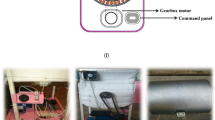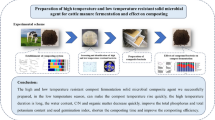Abstract
Recent intensive livestock production has made domestic animals vulnerable to infectious diseases such as foot and mouth disease. Infected animals and nearby animals are culled and then buried or incinerated to prevent the spread of the disease in most countries, including South Korea. The burial of animal carcasses in the soil may produce side effects, such as the production of leachate and odors, and could potentially spread infectious diseases. This study tested YM microorganisms, which mainly contain hyper-thermophilic organisms that can degrade pig carcasses and inactivate pathogenic microorganisms. An experimental burial system installed with an aeration facility was developed, and the decomposition effects of YM microorganisms were verified using pig carcasses. Pig carcasses were almost completely decomposed in 30 days without leachate, and all experimentally inoculated pathogens were completely inactivated by YM microorganisms. The final composites were satisfied with all inspection criteria for using the byproduct as fertilizer after an additional 34 days of composting. In conclusion, the newly developed hyper-thermophilic YM microorganism system may produce biosecure fertilizers from animal carcasses.




Similar content being viewed by others

Data availability
Data are contained within the article.
References
Herrero M, Thornton PK, Power B et al (2017) Farming and the geography of nutrient production for human use: a transdisciplinary analysis. Lancet Planet Health 1:e33–e42. https://doi.org/10.1016/S2542-5196(17)30007-4
Delgado C, Rosegrant M, Steinfeld H, et al (2016) Livestock to 2020: The Next Food Revolution. 105367/000000001101293427 30:27–29.
Gilroyed BH, Conrad C, Hao X et al (2016) Composting for biocontained cattle mortality disposal and associated greenhouse gas and leachate emissions. J Environ Qual 45:646–656. https://doi.org/10.2134/JEQ2015.06.0314
Hibi J, Kurosawa A, Watanabe T et al (2015) Post-traumatic stress disorder in participants of foot-and-mouth disease epidemic control in Miyazaki, Japan, in 2010. J Vet Med Sci 77:953–959. https://doi.org/10.1292/JVMS.14-0512
Jung T, Park H, Kwon JY, Sohn S (2022) The effect of equine assisted learning on improving stress, health, and coping among quarantine control workers in South Korea. Healthcare. https://doi.org/10.3390/HEALTHCARE10081564
Baba I (1900) Traditional methods of carcass disposal: a review. Vet Anim Res. https://doi.org/10.15406/jdvar.2017.05.00128
Davies RH, Wray C (1996) Seasonal variations in the isolation of Salmonella typhimurium, Salmonella enteritidis, Bacillus cereus and Clostridium perfringens from environmental samples. J Vet Med Ser B 43:119–127. https://doi.org/10.1111/J.1439-0450.1996.TB00295.X
Auty H, Mellor D, Gunn G, Boden LA (2019) The risk of foot and mouth disease transmission posed by public access to the countryside during an outbreak. Front Vet Sci 6:381. https://doi.org/10.3389/FVETS.2019.00381/BIBTEX
Lee J-I, Cho E-J, Lyonga FN et al (2021) Thermo-chemical treatment for carcass disposal and the application of treated carcass as compost. Appl Sci 11:431. https://doi.org/10.3390/APP11010431
Kalbasi-Ashtari A, Schutz MM, Auvermann BW (2008) Carcass rendering systems for farm mortalities: a review. J Environ Eng Sci 7:199–211. https://doi.org/10.1139/S07-051
Wang Z, Wu D, Lin Y, Wang X (2021) Role of temperature in sludge composting and hyperthermophilic systems: a review. BioEnergy Res 15:962–976. https://doi.org/10.1007/S12155-021-10281-5
Moriya T, Hikota T, Yumoto I et al (2011) Calditerricola satsumensis gen. nov., sp. nov. and Calditerricola yamamurae sp. nov., extreme thermophiles isolated from a high-temperature compost. Int J Syst Evol Microbiol 61:631–636. https://doi.org/10.1099/IJS.0.018416-0/CITE/REFWORKS
Chen G, An X, Feng L et al (2020) Genome and transcriptome analysis of a newly isolated azo dye degrading thermophilic strain Anoxybacillus sp. Ecotoxicol Environ Saf 203:111047. https://doi.org/10.1016/J.ECOENV.2020.111047
Chen G, An X, Li H et al (2021) Detoxification of azo dye direct black G by thermophilic Anoxybacillus sp. PDR2 and its application potential in bioremediation. Ecotoxicol Environ Saf. 214:112084. https://doi.org/10.1016/J.ECOENV.2021.112084
Wang Z, Wu S, Fan C et al (2022) Isolation and thermo-acclimation of thermophilic bacteria in hyperthermophilic fermentation system. Bioprocess Biosyst Eng 45:75–85. https://doi.org/10.1007/S00449-021-02640-5/METRICS
Synowiecki J (2016) Some applications of thermophiles and their enzymes for protein processing. Afr J Biotechnol 9:7020–7025. https://doi.org/10.4314/ajb.v9i42
Reuter T, Xu W, Alexander TW et al (2010) Biocontained carcass composting for control of infectious disease outbreak in livestock. J Vis Exp. https://doi.org/10.3791/1946
Payne J, Pugh B (2017) On-Farm Mortality Composting of Livestock Carcasses. online article of Oklahoma state university. https://extension.okstate.edu/fact-sheets/on-farm-mortality-composting-of-livestock-carcasses.html. Accessed 06 April 2023
Widowati, L. R., Saraswati, R., & Rochayati, S. (2011). Nitrogen cycling and composting technologies in livestock manure management. Kementerian Pertanian, Data Inventory and Mitigation on Carbon Emission and Nitrogen Cycling from Livestock in Indonesia. Badan Penelitian dan Pengembangan Pertanian. IAARD Press, Jakarta, pp 78–104.
Makan A, Fadili A (2020) Sustainability assessment of large-scale composting technologies using PROMETHEE method. J Clean Prod 261:121244. https://doi.org/10.1016/J.JCLEPRO.2020.121244
Krstic II, Radosavljević J, Djordjević A, et al (2019) Composting as a method of biodegradable waste management. Facta Univ Series Working Living Environ Prot. https://doi.org/10.22190/FUWLEP1802135I
Fitzpatrick GE, Worden EC, Vendrame WA (2005) Historical development of composting technology during the 20th century. Horttechnology 15:48–51. https://doi.org/10.21273/HORTTECH.15.1.0048
Azis FA, Rijal M, Suhaimi H (2022) Abas PE (2022) patent landscape of composting technology: a review. Inventions 7(387):38. https://doi.org/10.3390/INVENTIONS7020038
Fan S, Li A, ter Heijne A et al (2021) Heat potential, generation, recovery and utilization from composting: a review. Resour Conserv Recycl 175:105850. https://doi.org/10.1016/J.RESCONREC.2021.105850
Thakur V (2022) Sustainable cities and society 82 (2022) 103907 locating temporary waste treatment facilities in the cities to handle the explosive growth of HCWs during pandemics: a novel Grey-AHP-OCRA hybrid approach. Sustain Cities and Soc. https://doi.org/10.1016/j.scs.2022.103907
Thakur V, Parida DJ, Raj V (2022) Sustainable municipal solid waste management (MSWM) in the smart cities in Indian context. Int J Prod Perform Manag Ahead Print. https://doi.org/10.1108/IJPPM-10-2021-0588/FULL/XML
Thakur V (2021) Framework for PESTEL dimensions of sustainable healthcare waste management: Learnings from COVID-19 outbreak. J Clean Prod 287:125562. https://doi.org/10.1016/J.JCLEPRO.2020.125562
Thakur V, Ramesh A (2015) Healthcare waste management research: a structured analysis and review (2005–2014). Waste Manag Res 33:855–870. https://doi.org/10.1177/0734242X15594248
Thakur V, Ramesh A (2018) Analyzing composition and generation rates of biomedical waste in selected hospitals of Uttarakhand, India. J Mater Cycles Waste Manag 20:877–890. https://doi.org/10.1007/S10163-017-0648-7/TABLES/12
Funding
This work was supported by the Korea Institute of Planning Evaluation for Technology in Food, Agriculture, and Forestry (IPET) through the Animal Disease Management Technology Development Program funded by the Ministry of Agriculture, Food, and Rural Affairs (MAFRA) (Grant numbers: 318037-2 and 321010-1).
Author information
Authors and Affiliations
Contributions
Y-J.K. and I-S.C. performed the study conception and design. D-H.K. wrote and validated the manuscript. D-H.K., H–S.A., H-J.G., D-Y.K., J-H.K., and K-B.L. contributed to the preparation and experiments. J-H.K, Y-J.K, and I-S.C. supervised experiments. Y-J.K. and I-S.C. contributed to funding acquisition. All authors reviewed the final manuscript and approved its submission.
Corresponding authors
Ethics declarations
Conflicts of interest
The authors declare no conflicts of interest.
Additional information
Publisher's Note
Springer Nature remains neutral with regard to jurisdictional claims in published maps and institutional affiliations.
Rights and permissions
Springer Nature or its licensor (e.g. a society or other partner) holds exclusive rights to this article under a publishing agreement with the author(s) or other rightsholder(s); author self-archiving of the accepted manuscript version of this article is solely governed by the terms of such publishing agreement and applicable law.
About this article
Cite this article
Kim, DH., Ahn, HS., Go, HJ. et al. Development of a biosecure carcass composting method using a fermentation system containing hyper-thermophilic microorganisms. J Mater Cycles Waste Manag 25, 3522–3529 (2023). https://doi.org/10.1007/s10163-023-01774-w
Received:
Accepted:
Published:
Issue Date:
DOI: https://doi.org/10.1007/s10163-023-01774-w



